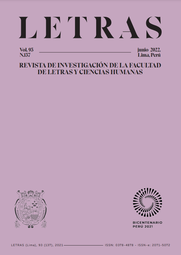Características de la modernidad tardía en El cuento de la criada
Resumen
Este artículo propone un estudio de El cuento de la criada (Margaret Atwood, 1985) dentro de la modernidad tardía mediante el examen de tres características: la teocracia, el patriarcado y el diálogo interno. Para cumplir el objetivo del artículo se contrastará la novela con las dos características que Zygmunt Bauman le achaca a esta modernidad tardía en la que si bien se ha producido un cambio con respecto a la primera modernidad no hay ruptura sino una continuación. La primera característica consiste en la pérdida del telos de la comunidad política. La otra característica que Bauman le adhiere a la modernidad tardía es un cambio en la perspectiva política en el que se renuncia a que sea la sociedad en su conjunto la que intente un cambio social y se privilegia la autoafirmación del individuo. Este trabajo se justifica porque una buena parte de los trabajos anteriores, que también estudian esta novela, son previos a la aparición del autodenominado Estado islámico y al empuje de movimientos populistas en Occidente; y, además, también son anteriores al movimiento Me Too. Esta obra permite adecuar las categorías de análisis a un momento histórico diferente al que signó varias de las novelas del canon distópico.Descargas
Métricas alternativas
Referencias bibliográficas
Alderman, N. (2017, 25 de marzo). Dystopian dreams: how feminist science fiction predicted the future. The Guardian. https://www.theguardian.com/books/2017/mar/25/dystopian-dreams-how-feminist-science-fiction-predicted-the-future
Atwood, M. (2017a, 10 de marzo). Margaret Atwood on What “The Handmaid’s Tale” Means in the Age of Trump. The New York Times. https://www.nytimes.com/2017/03/10/books/review/margaret-atwood-handmaids-tale-age-of-trump.html?_r=0
Atwood, M. (2017b [1985]). The Handmaid’s Tale. Vintage.
Bauman, Z. (2004). Modernidad líquida (3.ª reimpresión). Fondo de Cultura Económica.
Bauman, Z. (2017). Retrotopía. Barcelona.
Bloom, H. (2001). Modern critical interpretations of The Handmaid’s Tale. Chelsea House Publishers.
Bloom, H. (2003). Margaret Atwood’s the Handmaid’s Tale. Chelsea House Publishers.
Burgess, A. (1973). The clockwork condition (Publicado de nuevo en la edición de 4-11 de enero de 2012). The New Yorker. https://www.newyorker.com/magazine/2012/06/04/the-clockwork-condition
Fraser, N. y Nicholson L. (1988). Social Criticism without Philosophy: An Encounter between Feminism and Postmodernism. Theory, Culture, Society, 5, 373-394. https://doi.org/10.1177/0263276488005002009
Frye, N. (1965). Varieties of Literary Utopias. Daedalus, 94(2), 323-347.
Howells, C. A. (2006). The Cambridge Companion to Margaret Atwood. Cambridge University Press. https://doi.org/10.1017/CCOL0521839661
Huntington, S. (1996). The clash of civilizations and the remaking of World order. Simon & Schuster.
Jones, S. (2017, 20 de abril). The Handmaid’s Tale Is a Warning to Conservative Women. The New Republic. https://newrepublic.com/article/141674/handmaids-tale-hulu-warning-conservative-women.
Konner, M. (2015). Women after All. Sex, Evolution and the end of Male Supremacy. W. W. Norton and Company.
Kumar, K. (2010). The Ends of Utopia. New Literary History, 41(3) 549-569.
Macpherson, H. S. (2010). The Cambridge introduction to Margaret Atwood. Cambridge University Press. https://doi.org/10.1017/CBO9780511781018
Mead, R. (2017, 17 de abril). Margaret Atwood, the prophet of dystopia. The New Yorker. http://www.newyorker.com/magazine/2017/04/17/margaret-atwood-the-prophet-of-dystopia?mbid=amp_tw
Miller, B. y Moss, E. (Productores ejecutivos). (2017-2021). El cuento de la criada [serie de televisión]. Daniel Wilson Productions, Inc.; The Littlefield Company; White Oak Pictures; MGM Television.
Stein, K. (1991). Margaret Atwood’s The Handmaid’s Tale: Scheherazade in Dystopia. University of Toronto Quarterly, 61(2) 269-279. https://doi.org/10.3138/utq.61.2.269
Tennant, C. (2019). Religion in The Handmaid’s Tale. A brief guide. Mineápolis: Fortress Press. https://doi.org/10.2307/j.ctvcb5bp1
Tolan, F. (2007). Margaret Atwood: Feminism and Fiction. Ámsterdam, Nueva York: Rodopi. https://doi.org/10.1163/9789401204545
Weigel, M. (2017, 26 de abril). We live in the reproductive dystopia of The handmaid’s tale. The New Yorker. http://www.newyorker.com/books/page-turner/we-live-in-the-reproductive-dystopia-of-the-handmaids-tale?mbid=social_twitter
White, H. (2009 [1993]). Francis Bacon. En J. Cropsey y L. Strauss (Comps.), Historia de la filosofía política (6.ª reimpresión) (pp. 350-367). Fondo de Cultura Económica.
Whitehead, A. L. y Perry, S. L. (2020). Taking America Back for God: Christian nationalism in the United States. Oxford University Press. https://doi.org/10.1093/oso/9780190057886.001.0001
Derechos de autor 2022 Letras (Lima)

Esta obra está bajo licencia internacional Creative Commons Reconocimiento 4.0.
Este obra está bajo una licencia de Creative Commons Reconocimiento 4.0 Internacional



















